
Care and Maintenance
General advice
Never touch the strings of a piano with your bare hands, or corrosion could start. If for any reason you need to touch the strings, make sure you wear clean cotton gloves.
PLAY YOUR PIANO. This is the first preventative measure against pianos two worst enemies: humidity and pests (read below for more information).
Pianos need attention!
First and foremost, pianos must be played! Because of the high number of moving parts in a piano and the construction materials used, there is a risk of parts seizing if the piano isn’t played regularly and for long periods.
Furthermore regular maintenance is required: the wood and felt in pianos is affected over time by wear and tear and by such issues as humidity and pests. Additionally, if the instrument is not tuned regularly, it can move far enough from normal tension (concert pitch, 440hz) that multiple consecutive tunings will be required to stabilize the instrument (see Pitch Adjustment). Pianos should normally be tuned at least once a year.
Environment and Installation
The relative humidity of the piano’s environment is of critical importance (see "Humidity and Pianos" below). Pianos must be installed away from direct sun and heat sources. Bodies of water such as large fish tanks should be in a separate room, and no water should be allowed in the immediate vicinity of the piano. A humidity data logger is an important device to acquire.
Your piano should ideally be located against an inside wall in a room with no drafts, leveled with a spirit level and stable on its legs or casters (no rocking motion). The piano should not be in the direct sunlight at any time of the day. Good airflow in the room is important.
Please keep free space on the right hand side of the piano (minimum 40cm). Failing that, the top octave and a half of your instrument cannot be tuned.
Before getting a piano
Getting professional advice before commiting to purchase a new or second hand instrument can save you money and the potential for mistakes.
We advise all prospective and current piano owners to place an accurate hygrometer or humidity data logger inside the piano or in the location you would place a piano in your home. This can collect valuable data to define where to position your piano in your home, which humiditiy control solution best apply to your situation, or to track appearing issues with a scientific approach.
Second hand pianos
Image courtesy of Paul Lafrance - www.paullafrancedesign.com
Before buying a second hand piano, it is essential to have its condition assessed by a professional as it may require work which makes the purchase economically unviable. Lack of maintenance, lack of being played, and the effects of environmental factors over time mean that pianos may become unserviceable. We advise to send through pictures of the inside of the piano before organising an inspection with our technician.
Alternatively you could read the rest of this page as well as this article to gather some keys to inspect a second hand piano yourself.
Disposing of your old piano
If your instrument is no longer serviceable, you can choose to up-cycle it (mini-bar, writing desk…). Alternatively, you can contact a piano transporter (see “Transporting Pianos” below) and ask them to dispose of it at your local tip. The charge is $310 per tonne, most upright pianos weigh between 200 kg and 350 kg.
Transporting pianos
There is both a risk of physical injury and a risk to the piano if it is transported incorrectly. Transporting pianos should be left to professionals. We fully trust and recommend:
South West Rocks based - Country Care Removals - Bon: 0408 653 938
Alstonville based - J&J Transport - Andrew: 0427 781 435
Pianos need to spend four to six weeks in a new environment prior to tuning, in order to adjust to the new humidity levels.
How does a piano work?
This explanatory video from the ABC gives a clear overview of the workings of a grand piano. The link below offers a written article and additional instructive videos.
Humidity and pianos
The ideal RH for a piano is 40 to 60%, while 42% is optimal ; The wood and felt in pianos swells at higher RH and shrinks at lower RH High RH (60% and above) results in sharp pitch, sticking keys, ringing notes and other issues . Low RH (40% and below) results in flat pitch, ungluing of joints, loose hammers and keys, and other issues . Where RH is unstable, constant swelling and shrinking of wood and felt can accelerate wear and tear, resulting in increased maintenance costs ( $!! ). Unstable RH levels will eventually lead to irreparable damage.
























More on humidity
"Relative humidity (RH) is the amount of moisture in the air as a percentage of the amount the air can actually hold. Warmer air can hold more moisture than cooler air, which means that for a given amount of atmospheric moisture, RH will be lower if air is warm than it would be if the air is cool."
Monitoring RH
Hygrometers are used to measure RH. Piano owners should always monitor RH with a hygrometer. Cheaper hygrometers can be inaccurate . Dust and other airborne contaminants can also cause inaccuracy, even within short periods of time. We recommend hygrometers which are accurate to within 2% and have a memory function that keeps track of RH levels overnight. They can be placed on top or inside the piano. Hygrometers need to be replaced or calibrated regularly.
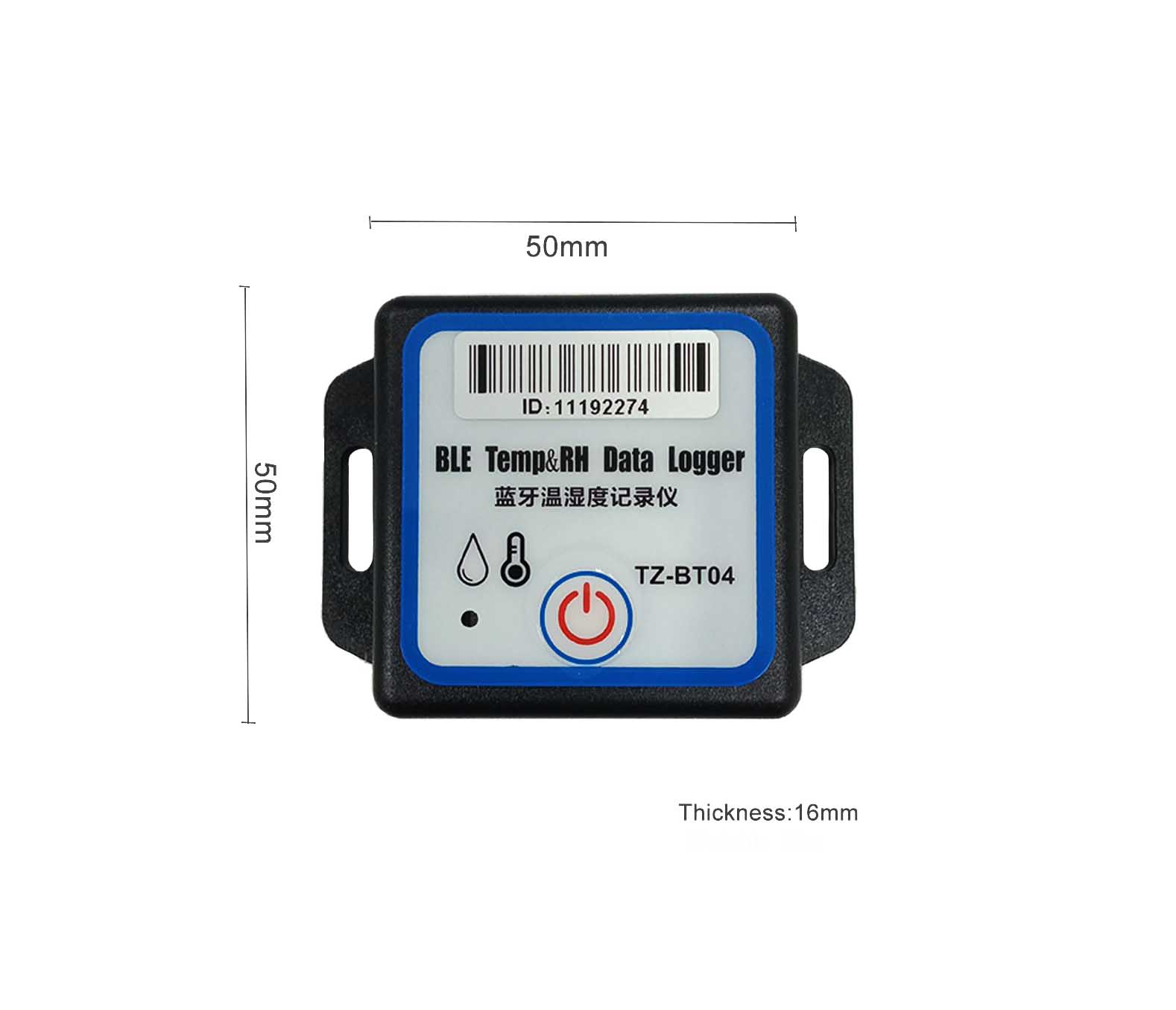
Solutions to humidity...
... for everyone: PLS – Piano Life Saver System
This is our recommended solution to humidity issues. The PLS is a humidity control system installed in the piano, creating the correct micro-environment within the piano cavity. Limited maintenance is required on some systems, including regular addition of water. The PLS is the only known system for totally enclosed humidity control. It is the best solution to humidity issues, and inexpensive to run.
The system being encapsulated inside an upright piano it efficiently controls moisture content of the structure and the action; in a grand piano the system is located under the soundboard, adjusting moisture content of the structure but not the action.
! A hygrometer is essential to constantly monitor the system is working correctly. Elements of a system may fail but are all covered by a 5 years manufacturer warranty.
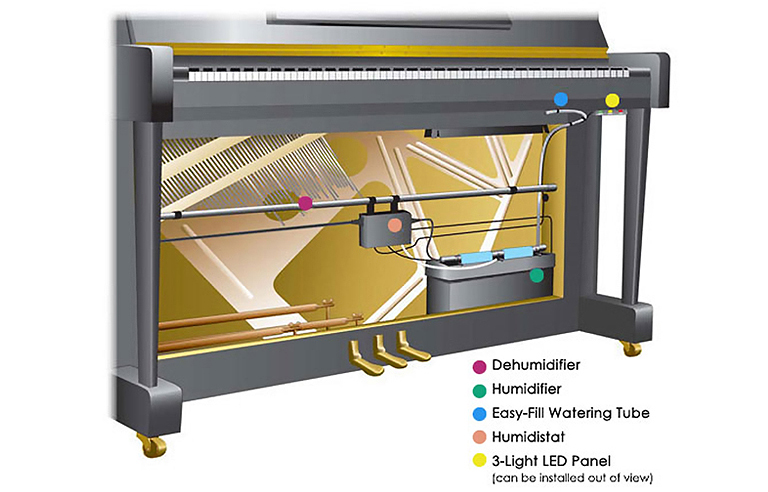
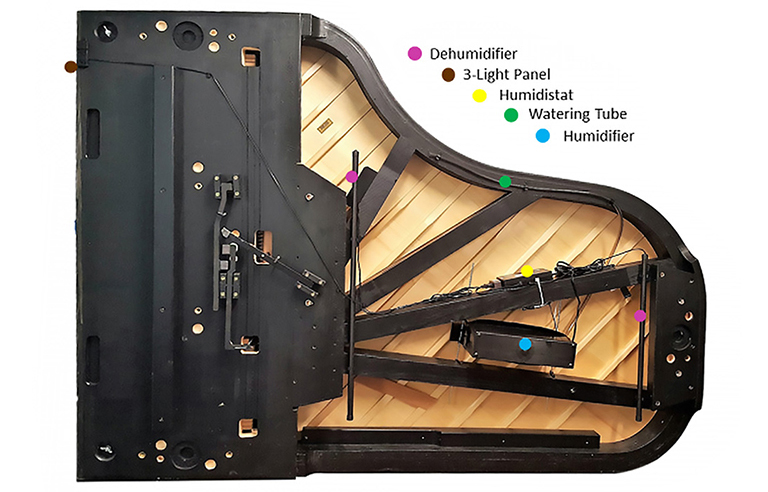
... for everyone: Covers
Perfect complement to a PLS, a good quality cover on top of a piano will effectively protect it from direct humidity. Innapropriate cover materials will desintegrate after a while, eventually bringing a lot of undesired dust inside the piano.
For grand pianos, we advocate for covers with flaps so the music rack can be positioned on top of the piano, hence nullifying the need to even partially open the piano for daily practice, when the instrument could be exposed.
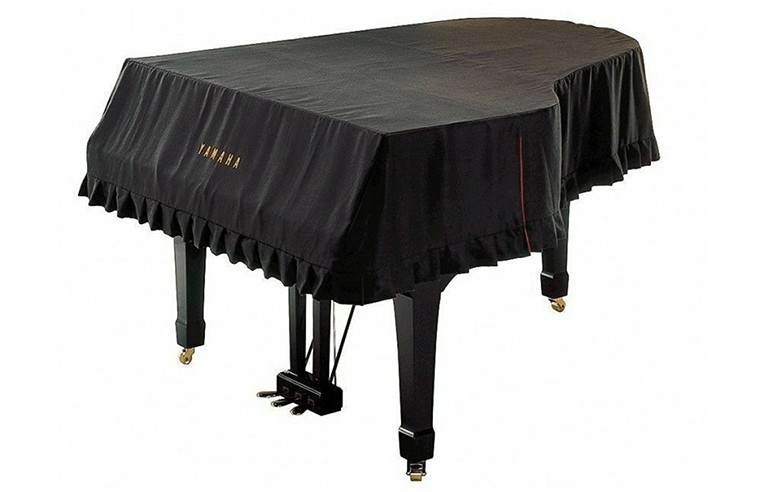
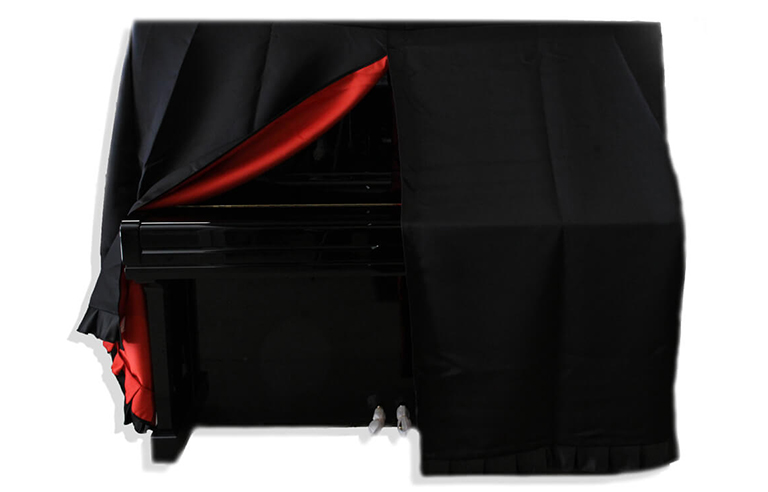
For grand pianos that need to stay open, a 100% wool Dawson String Cover will hinder rust and corrosion of the crucial parts of your piano such as the strings, tuning pins, hitch pins and other crucial metal parts.
... for other situations
... for highly valued pianos: Humidity-controlled rooms
These require both a room dehumidifier and a room humidifier. These devices need to have water added or removed daily, however the water from dehumidifiers can also be piped outside the room. Dehumidifiers use a lot of power, and can therefore be expensive to run. They are also noisy, meaning piano users may choose to switch them off whilst playing, thus obviating the benefits.
... for institution: Humidity-controlled buildings
Full-building humidity control is integrated into the building’s central heating and air conditioning systems. Although this is the ultimate solution for humidity issues, it is expensive to install, and is usually limited to specialized facilities such as music schools and concert halls.
In the case of a rarely used large concert hall, running air-conditioning and dehumidifying devices 24/7 may not be viable nor eco-friendly. In this instance, as an alternative to full humidity-controlled buildings, pianos may be stored in special sealed storage rooms and rolled out onto the stage for concerts.
! NOT A SOLUTION: Desiccants
These are chemicals that remove water from the air. They can also be prone to the issue of releasing their humidity again. Desiccants may be beneficial in situations with minor humidity fluctuations. As they retain moisture within the piano, they need to be replaced often, in many cases daily.
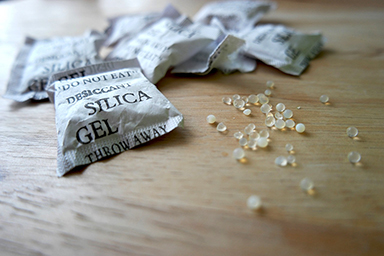
Pests
Insects such as moths and cockroaches can nest inside pianos and feed on the instrument’s felts, causing a number of issues and necessitating costly repairs.
Mice can be very destructive, chewing through keys, felts and other action parts. In time, they can pack enough nesting and other material under the keyboard to render the keys immoveable. Mice faeces and urine are also destructive, with the highly acid urine rusting metal parts of the piano. Damaged pianos may be costly or impossible to repair. To prevent mice getting inside pianos, they must be kept shut, and all gaps must be plugged.
























Camphor sticks (available from hardware stores) can be suspended inside the piano, for example from an action bracket between the bracket and the side of the cabinet. Camphor sticks will act as a repellant and need to be replaced several times a year as the camphor evaporates.
PLAY YOUR PIANO! If your piano sits unused for extended periods of time, it will be an appealing nesting ground for all sorts of pests.
To replace the camphor sticks in your upright piano, open the top lid and position two new camphor sticks, one on the right-hand side and one on the left-hand side action brackets (see images below). Make sure you don’t touch the strings with your hands when doing so or they could start rusting. Make sure the camphor is not in the way of anything mechanical, check the end keys after installing new sticks.
...
- The fortepiano was invented in Italy in the early 18th century by Italian inventor Bartolomeo Cristofori.
- A modern piano typically has around 10,000 moving parts.
- The strings exert around 15 tonnes of tension on the instrument’s structure.
- The wood, felt and metal used to build a piano are easily affected by environmental factors such as humidity.


